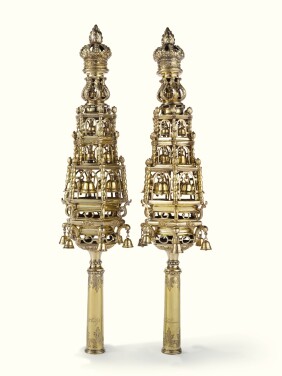P hilip Salomons (1796-1867) was the son of Levy Salomons and Mathilda Metz. He traveled in America when young, joining the household of Aaron Levy in New York in 1824, and became a naturalized American citizen in 1826; a cane of wood from Washington’s tomb at Mount Vernon is preserved in the Salomons museum at Broomhill, Tunbridge Wells, Kent. However, Philip returned to England later that year and resumed his British citizenship, becoming a financier in the City of London, like his father and his younger brother David. He also followed his father as a Warden for the New Synagogue, London, and presented his father’s 400 volumes of “Hebrew and Rabbinical works” to the Guildhall Library in London (transferred in the later twentieth century to the Mocatta Library). Philip was friends with the artist David Roberts, who gave him in 1846 a fragment of the Western Wall acquired in Jerusalem while Roberts was working on his famous Sketches in the Holy Land and Syria.

Philip married in 1850 Emma Abigail Montefiore, daughter of Jacob Montefiore, “merchant of Sydney, New South Wales,” and relative of Moses Montefiore; the bride was 17 and the groom 54. He served as a Justice of the Peace, and in 1852 as Sheriff of Sussex. His political career, though, was eclipsed by that of his brother, who was Sheriff of the City of London and then of Kent, Alderman of London, and in 1855 the first Jewish Lord Mayor of London. Due to her sister-in-law’s ill health, Emma sometimes filled the place of Lady Mayoress. She herself, though, died in 1859, leaving Philip with several young children. Her husband only survived her by eight years, and on his death their children were entrusted to the care of Sir David; Philip’s son David succeeded his uncle as 2nd Baronet.
The advertisement for Philip’s estate sale in 1867 described him as “that well-known Amateur” and reveals a collector with strong antiquarian leanings: several Sèvres vases and cups, oriental vases “from the Duke of Sussex’s collection,” mounted rock crystal pieces, gold snuff boxes and bonbonnières, French clocks, and “tables and pedestals of rich Buhl and marquetrie” with plaques of pietre dure and Sèvres—a taste that was shared with his contemporaries the Rothschilds, in contemporary houses such as Mentmore and Ferrières.

The sale included “ancient manuscripts in finely chased covers,” which probably belonged to the collection for which Philip is best known today, that of his Judaica. He was one of the first serious buyers of antique Judaica, buying not just contemporary English items for use, but choosing also to acquire modern and historic European forms as well. His collection was mainly displayed in his rooftop synagogue at 26 Brunswick Terrace, Hove, where it was admired by contemporaries. As more of his pieces are documented, sets begin to appear: the Dutch finials by Hedde Buys (lot 20) have a matching pointer (lot 21), both probably enriched with stones and engraving in England, and the pointer by Henry Green (lot 24) matched a pair of finials sold from the Sassoon family collection in 2000—thus reinforcing the idea that his Judaica was for use and not just for display.
On Philip’s death, part of his Judaica collection was sold with his other possessions; a Kiddush cup (see below) from the sale was engraved with the provenance, showing the sale was considered significant at the time. Two pairs of finials were acquired by the Central Synagogue, London, which was about to start its new building on Great Portland Street. Some pieces were retained by the family and are now in the Salomons Museum in Kent. However, the largest portion was acquired by Reuben David Sassoon, recently arrived in England from Bombay and a neighbor of Salomons at Hove. These would be the beginning of an even greater collection, but the importance of the Salomons material was such that it was still singled out in the introduction to Reuben’s display at the 1887 Anglo-Jewish Historical Exhibition at the Royal Albert Hall, twenty years after Philip’s death.

In addition to the following lots, several other pieces from Philip Salomons’ collection are known today, helped by his habit of engraving his name:
- Pair of Torah Finials by Henry Green, London, 1790 (Reuben D. Sassoon collection, sold Sotheby’s, Tel Aviv, October 27, 2000, lot 21)
- Pair of Dutch filigree Torah Finials (Reuben D. Sassoon collection, sold Sotheby’s, Tel Aviv, October 27, 2000, lot 36)
- Pair of German Torah Finials by Jürgen Richels, Hamburg, circa 1670 (Reuben D. Sassoon collection, no. 2037 in 1887; sold Sotheby’s, Tel Aviv, April 9, 1999, lot 15)
- Eastern European Torah Crown (Reuben D. Sassoon collection, no. 2052 in 1887; Bevis Marks Synagogue)
- Pair of Torah Finials, Abraham de Oliveyra, London, 1740 (Reuben D. Sassoon collection, sold Kedem, Tel Aviv, November 15, 2016, lot 108)
- Plaque of the Tablets of the Law, possibly Italian, 18th century, from the private synagogue at 26 Brunswick Terrace, Hove (Salomons Museum, near Tunbridge Wells, Kent)
- Pair of Embroideries, metal thread on red velvet, probably Italian, 18th century; most likely used as reading desk covers in Salomons’ private synagogue (Salomons Museum, near Tunbridge Wells, Kent)
- Swiss silver-gilt Kiddush Cup for festivals, Johannes (Hans) Scheuchzer II, Zurich, circa 1680. Engraved “purchased from the effects of the late Philip Salomons at Christies” (sold Sotheby’s, Geneva, May 16, 1994, lot 64)
- Pair of Torah Finials by Edward Aldridge, London, 1764 (Central Synagogue, London, sold Sotheby’s, New York, June 5, 2019, lot 3; now in the Museum of Fine Arts, Boston)
- Pair of Torah Finials by John Robins, London, 1803 (Central Synagogue, London, sold Sotheby’s, New York, June 5, 2019, lot 6)
- Pair of Torah Finials by Samuel Edlin, London, 1712 (Jewish Museum, London)









